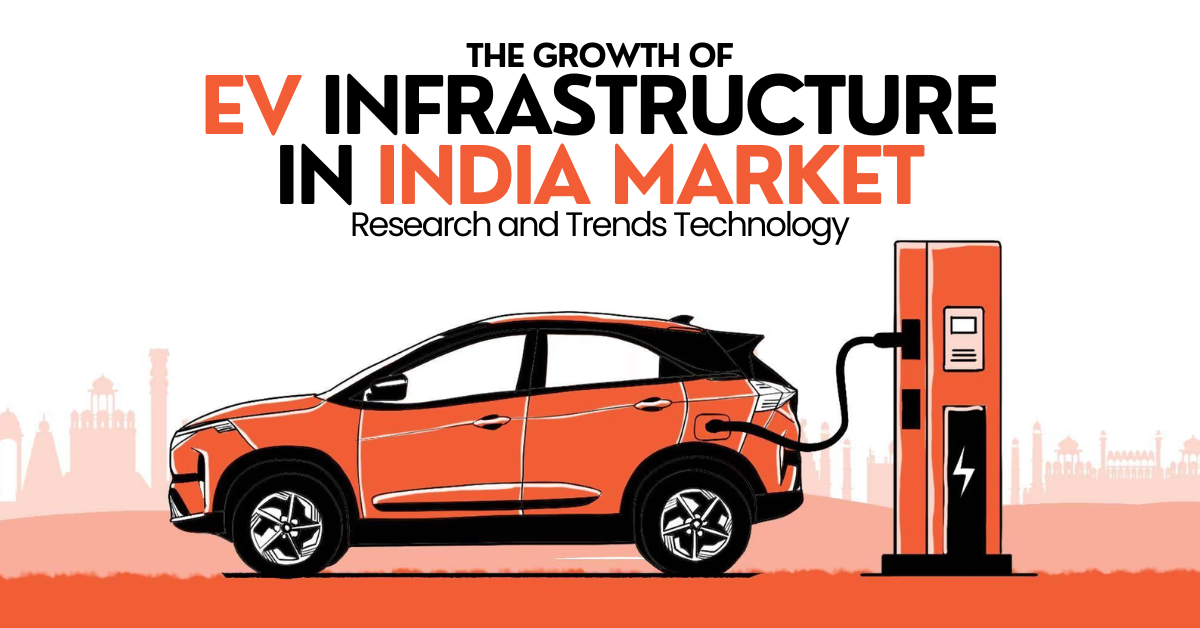Introduction: India’s Electric Vehicle Journey Has Begun
India is at the cusp of an electric revolution. While electric vehicles (EVs) were once seen as a niche innovation, today they represent a national mission — one driven by the need to reduce emissions, cut fuel imports, and build a cleaner, smarter transport ecosystem.
But for this transition to succeed, EV infrastructure — particularly charging stations — must grow just as fast as the vehicles themselves.
This blog explores the current status, market trends, and future outlook of EV infrastructure in India — with insights that every policymaker, startup, and citizen needs to know.
India’s EV Push: Why Infrastructure Is Key
The Indian government aims to have 30% of all vehicles electric by 2030. But owning an EV in India is still challenging due to:
Limited public charging stations
Range anxiety in long-distance travel
Uneven development across states
Building a robust, accessible EV charging network is the bridge between ambition and adoption.
Current State of EV Infrastructure (2025)
| Metric | Status (2025) |
|---|---|
| Total public charging stations | 13,000+ and growing rapidly |
| Major cities with EV charging networks | Delhi, Mumbai, Pune, Bengaluru, Hyderabad |
| Fast chargers (DC) share | 15-20% of total installations |
| Battery swapping stations | Increasing presence in Tier 2/3 cities |
| Leading infrastructure players | Tata Power, Statiq, Ather Grid, ChargeZone |
The infrastructure is growing but still urban-heavy, with rural and highway corridors still underserved.
Government Policies Fueling EV Infra Growth
✅ FAME II (Faster Adoption and Manufacturing of Hybrid & Electric Vehicles)
Offers incentives for EV buyers and charging station developers.
✅ State EV Policies
States like Delhi, Maharashtra, Tamil Nadu, and Gujarat offer land subsidies, tax rebates, and infrastructure incentives.
✅ Battery Swapping Policy (2022 onwards)
Encourages companies to set up battery swapping stations to reduce charging time for two- and three-wheelers.
✅ National Electric Mobility Mission
Focuses on building a phased EV infrastructure roadmap aligned with national targets.
These policies have attracted public-private partnerships and foreign investment, fueling the infrastructure race.
Key Market Trends in EV Infrastructure (2025)
1. Rise of Fast-Charging Corridors
Highways like the Mumbai-Pune Expressway and Delhi-Chandigarh corridor now feature fast-charging stations every 40-60 km. This trend is expanding to more intercity routes to enable long-distance EV travel.
2. Battery Swapping Goes Mainstream
For commercial vehicles (autos, e-rickshaws, delivery bikes), battery swapping saves time and cost. Startups like SUN Mobility and Bounce Infinity are scaling swap stations, especially in logistics-heavy areas.
3. Corporate & Retail Integration
Retail chains, office parks, and shopping malls are adding charging points in parking lots. For instance, Reliance and Adani are integrating EV stations into their retail networks.
4. Tech-Driven Station Discovery
Apps like EV Plugs, Tata EZ Charge, and ChargeGrid help users locate nearby stations, check availability, and pay digitally, improving convenience and trust.
5. Solar-Powered Charging Stations
To reduce grid load and promote sustainability, companies are piloting solar-powered charging hubs in semi-urban regions.
Challenges Slowing Infrastructure Growth
Despite progress, several hurdles remain:
High installation costs for fast chargers
Land availability in dense urban areas
Power supply and grid integration issues
Lack of standardization in connectors and charging protocols
Limited awareness among potential EV buyers
To overcome these, India needs coordination across ministries, DISCOMs, urban bodies, and private players.
Opportunities for Startups and Investors
The EV infrastructure ecosystem is wide open for innovation in:
Charger manufacturing and installation
Battery leasing and swapping tech
EV fleet energy management platforms
Smart metering and load balancing solutions
Modular mobile charging vans for emergency refueling
With over 200 million vehicles on Indian roads, the potential for retrofit, upgrade, and service is massive.
Future Outlook: Where Is EV Infra Headed by 2030?
100,000+ public chargers expected nationwide
Fast-charging highways to cover all metros and major state capitals
EV-ready buildings made mandatory in urban planning codes
Smart grid integration for better energy efficiency
Pan-India battery swapping networks for delivery fleets
As electric two-wheelers, buses, and delivery vehicles dominate urban transport, charging infrastructure will define how inclusive and sustainable this EV future really is.
Conclusion: Powering the EV Dream, One Station at a Time
India’s EV story is more than just shiny cars and silent scooters — it’s about building a nationwide backbone of smart, fast, and accessible charging solutions.
With policy support, private innovation, and public awareness, EV infrastructure is no longer a future goal — it’s today’s opportunity.
Whether you’re a business leader, investor, policymaker, or everyday commuter, this is the moment to plug in — and power up.
Read







